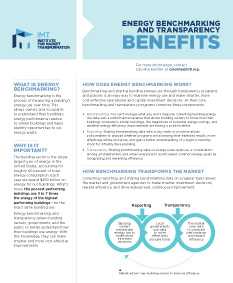What is energy benchmarking and why is it important? The core energy efficiency policy that IMT supports is the benchmarking and transparency of buildings’ energy use. Benchmarking means measuring a building’s energy use and then comparing it to the average for similar buildings. It allows owners and occupants to understand their building’s relative energy performance, and helps identify opportunities to cut energy waste. We believe that sharing this data can also drive the market to recognize and reward energy efficiency and create a continuous cycle of improvement and demand for high-performing buildings.
Benchmarking and transparency policies are growing across the U.S. (see our map and charts tracking progress here), and as of March 2017 these policies affected more than 10 billion square feet of floor space in major real estate markets—making them powerful catalysts for energy efficiency in the built environment. As more of these policies become enacted and more data is gathered and analyzed, the list of benefits offered through benchmarking and transparency to building owners and tenants, government agencies, and utilites continues to grow.
In this two-page fact sheet, IMT highlights a range of these benefits, from increased competition and market choice to job creation and energy and cost savings. We also explore how this growing pool of data is allowing government agencies, utilities, and building owners to make more cost-effective and smarter business decisions.
Click on the link at right to download a PDF of the fact sheet, which includes embedded links to source material for further information. And, to learn more about individual benchmarking and transparency policies across the globe, consult the policy briefs on our sister website BuildingRating.org.
The version of IMT’s benchmarking and transparency benefits fact sheet linked here is intended for online use. If you would like a version that is designed for printing and distributing as a hard copy, please contact Katie Weeks.
